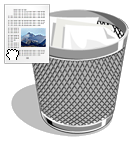Drag and Drop for Dart web apps with mouse and touch support.
GitHub | Pub | Demos and Examples
- Use any HTML Element as
DraggableorDropzone. - Mouse and Touch dragging.
- Draggable events:
dragStart,drag, anddragEnd - Dropzone events:
dragEnter,dragOver,dragLeave, anddrop - Drag avatars as visual indication of a drag operation:
- Original element as drag avatar.
- Clone as drag avatar.
- Custom drag avatar.
- Support for Shadow DOM (Web Components, Custom Elements, Polymer, etc.).
- Much more... see examples.
Before you read the instructions below, you should take a look at the examples.
Create a Draggable and give it some HTML elements; this will make them
draggable. You can either pass a single Element to the constructor or an
ElementList that is returned by querySelectorAll.
If you also want to drop somewhere, you'll need a Dropzone.
// Install draggable (no avatar).
Draggable draggable = Draggable(querySelectorAll('.draggable'));
// Install dropzone.
Dropzone dropzone = Dropzone(querySelector('.dropzone'));You'll most likely want some drag avatar to show the user that a drag is
going on. There are two predefined AvatarHandlers that you can use as follows.
But you could also provide your own implementation of AvatarHandler.
// Draggable with clone as avatar.
Draggable draggable = Draggable(querySelectorAll('.draggable'),
avatarHandler: AvatarHandler.clone());
// Draggable with original element as avatar.
Draggable draggable = Draggable(querySelectorAll('.draggable'),
avatarHandler: AvatarHandler.original());The following options can be passed as named parameters to the constructor of
Draggable:
-
avatarHandler: Is responsible for creating, position, and removing a drag avatar. A drag avatar provides visual feedback during a drag operation. Here are possible options (see above for an example):null(the default) - will not create a drag avatarAvatarHandler.original()- handler that uses the original draggable as avatar. SeeOriginalAvatarHandler.AvatarHandler.clone()- handler that uses a clone of the draggable element as avatar. SeeCloneAvatarHandler.- A custom
AvatarHandler- you can provide your own implementation ofAvatarHandler.
-
horizontalOnly: If set to true, only horizontal dragging is tracked. This enables vertical touch dragging to be used for scrolling. -
verticalOnly: If set to true, only vertical dragging is tracked. This enables horizontal touch dragging to be used for scrolling. -
handle: If handle query String is specified, it restricts the dragging from starting unless it occurs on the specified element(s). Only elements that descend from the draggables elements are permitted. -
cancel: If cancel query String is specified, drag starting is prevented on specified elements. -
draggingClass: Is the css class set to the dragged element during a drag. If set to null, no such css class is added. -
draggingClassBody: Is the css class set to the html body tag during a drag. If set to null, no such css class is added. -
minDragStartDistance: Is the minimum distance in pixels that is needed for a drag to start. Default is4. This allows for clicks with tiny movement.
Available event Streams on Draggable:
-
onDragStart: Fired when the user starts dragging.
Note:onDragStartis fired not on touchStart or mouseDown but as soon as there is a drag movement. When a drag is started anonDragevent will also be fired. -
onDrag: Fired periodically throughout the drag operation. -
onDragEnd: Fired when the user ends the dragging.
Note: Is also fired when the user clicks the 'esc'-key or the window loses focus.
The following options can be passed as named parameters to the constructor of
Dropzone:
-
acceptor: Is used to determine whichDraggables will be accepted by thisDropzone. If none is specified, allDraggables will be accepted. -
overClass: Is the css class set to the dropzone element when an accepted draggable is dragged over it. If set to null, no such css class is added. -
invalidClass: Is the css class set to the dropzone element when a not-accepted draggable is dragged over it. If set to null, no such css class is added.
Available event Streams on Dropzone:
-
onDragEnter: Fired when aDraggableenters thisDropzone. -
onDragOver: Fired periodically while aDraggableis moved over aDropzone. -
onDragLeave: Fired when aDraggableleaves thisDropzone. -
onDrop: Fired when aDraggableis dropped inside thisDropzone.
Note: Dropzone events are only fired when the Draggable is accepted by
the Acceptor.
Web Components create a nice ecapsulation through Shadow DOM. But this creates
a problem with dropzones inside the Shadow DOM as they never receive events
because all events are captured by the host element. To make this work we need
to retarget events to the Shadow DOM children through recursive
elementFromPoint() calls.
For performance reasons it wouldn't make sense to retarget all drag and drop
events. If you wish to retarget events to the Shadow DOM children, you must add
a dnd-retarget attribute to the host:
// Retarget drag and drop events to Shadow DOM children.
<my-element dnd-retarget></my-element>The Dart Drag and Drop library is inspired by
Thank you for your work!
- Run from the terminal:
webdev serve - Build from the terminal:
webdev build
The MIT License (MIT)


